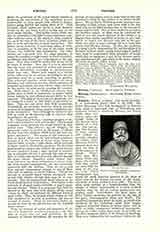

Vischer, PETER, sculptor and metal founder, b. at Nuremberg about 1460; d. in 1529. His father Hermann, who had immigrated to Nuremberg, made a baptismal font at Wittenberg, and memorial brasses at Bamberg, Meissen, and Posen, which show evidences under the Gothic forms of the greater naturalness of a new era. His son carried this freedom of form further, still without essentially changing the Gothic style. However, later, he adopted more and more the ideas of the Renaissance in details. Peter’s three sons, Hermann, Peter, and Hans, who worked with him, carried out more fully the ideas of the new period. This circumstance has raised the much disputed question of the share of these sons in the formal execution of the works, especially of those produced from 1505. The father often made castings as a bronze-founder from the designs of others, consequently it is often doubted whether what he did in various productions was original work. Nevertheless, the ideal figure of Peter Vischer maintains its position by the side of his great contemporaries Stoss and Krafft. The sepulchral monuments which he made, or which were produced by his workshop, range from simple, engraved memorial brasses or bronze plates cast in relief to richly ornamented sepulchral monuments. Among his earlier works, those made about 1490, are the three memorial tablets of the bishops of Bamberg. They were followed by the sepulchral tablets for the princely house in the cathedral at Meissen, and the episcopal tombs at Breslau and Magdeburg. These works contain some curious details; in one it is the carpet spread out back of the recumbent body with a perspective background and scrolls in the Renaissance style; in another the horizontal churchdoorway in which the recumbent body is, so to speak, placed upright under a baldachino.
From 1505 Vischer was at work on his master-piece, the sepulchral monument to St. Sebaldus, which, according to an inscription, he finished with the aid of his sons in 1519. The structure as a whole has great dignity and a compact unity, although the fundamental Gothic form has some Romanesque additions, and a large number of small Renaissance figures surround the monument. The rectangular base has an ornamental candlestick at each corner; each of the longer sides of the base presents in relief two scenes from the life of St. Sebaldus, patron of Nuremberg: Sebaldus draws fire from an icicle, fills an empty jug with wine, gives sight to a blind man, and causes the earth to swallow a mocker. On one of the shorter sides stands an ideal figure of the saint, on the other a figure after real life of Vischer himself wearing a leather apron, as when at work. The structure terminates above in Gothic arches and dome-like pyramids, the one in the center supporting the Infant Jesus with the orb. Below the top, on a pedestal and clearly seen from all sides, is the silver shrine of the saint. In front of the columns of the structure rise candelabra, which bear figures of the Apostles. The tops of the main columns support figures from the Old Testament. For protection the spans of the arches are equipped with two columns, one standing above the other; the lower column rises as high as the socle, the upper, which rises much higher, has at its top a stately capital. The other similar parts of this chapel-like monument give proof of the richness of imagination of the master.
The fine statues of King Arthur and King Theodoric, which form a part of the monument to the Emperor Maximilian in the court church at Innsbruck, are also, according to the original documents, the work of Vischer’s workshop and should be ascribed chiefly to Peter the elder (1513). In later works the part taken by the sons is more and more evident. The Madonna of Nuremberg is also held to be a production of Vischer’s workshop.
G. GEITMANN

